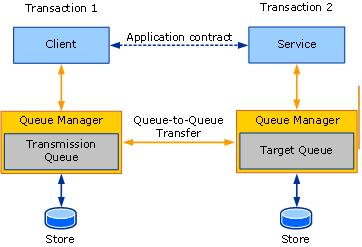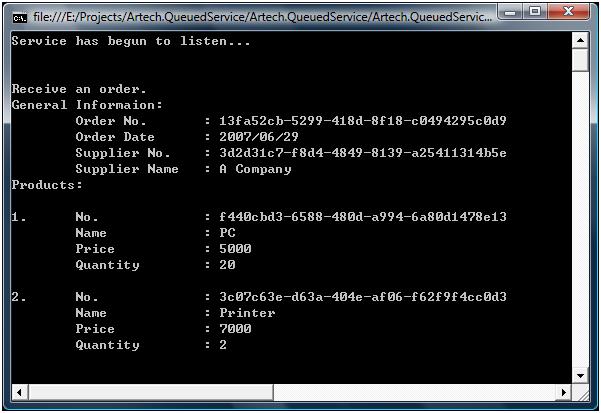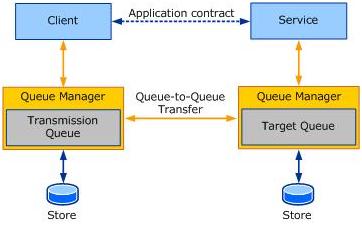一、为什么要使用MSMQ
在一个分布式的环境中,我们往往需要根据具体的情况采用不同的方式进行数据的传输。比如在一个Intranet内,我们一般通过TCP进行高效的数据通信;而在一个Internet的环境中,我们则通常使用Http进行跨平台的数据交换。而这些通信方式具有一个显著的特点,那就是他们是基于Connection的,也就是说,交互双方在进行通信的时候必须保证有一个可用的Connection存在于他们之间。而在某些时候,比如那些使用拨号连接的用户、以及使用便携式计算机的用户,我们不能保证在他们和需要访问的Server之间有一个的可靠的连接,在这种情况下,基于Messaging Queue的连接就显得尤为重要了。我们今天就来谈谈在WCF中如何使用MSMQ。
MSMQ不仅仅是作为支持客户端连接工具而存在,合理的使用MSMQ可以在很大程度上提升系统的Performance和Scalability。我们先来看看MSMQ能给我们带来怎样的好处:
1.MSMQ是基于Disconnection
MSMQ通过Message Queue进行通信,这种通信方式为离线工作成为了可能。比如在介绍MSMQ时都会提到的Order Delivery的例子:在一个基于B2C的系统中,订单从各种各样的客户传来,由于 客户的各异性,不能保证每个客户在每时每刻都和用于接收订单的Server保持一个可靠的连接,我们有时候甚至允许客户即使在离线的情况下也可以递交订单(虽然订单不能发送到订单的接收方,但是我们可以通过某种机制保证先在本地保存该订单,一旦连接建立,则马上向接收方递交订单),而MSMQ则有效地提供了这样的机制:Server端建立一个Message Queue来接收来个客户的订单,客户端通过向该Message Queue发送承载了订单数据的Message实现订单的递交。如果在客户离线的情况下,他仍然可以通过客户端程序进行订单递交的操作,存储着订单数据的Message会被暂时保存在本地的Message Queue中,一旦客户联机,MSMQ将Message从中取出,发送到真正的接收方,而这个动作对于用户的透明的。
2.MSMQ天生是One-way、异步的
在MSMQ中,Message始终以One-way的方式进行发送,所以MSMQ具有天生的异步特性。所以MSMQ使用于那些对于用户的请求,Server端无需立即响应的场景。也就是说Server对数据的处理无需和Client的数据的发送进行同步,它可以独自地按照自己的Schedule进行工作。这可以避免峰值负载。比如Server端可以在一个相对低负载的时段(比如深夜)来对接收到的Order进行批处理,而无需一天24小时一直进行Order的监听、接收和处理。
3.MSMQ能够提供高质量的Reliable Messaging
我们知道,在一般的情况下,如果Client端以异步的方式对Service进行调用就意味着:Client无法获知Message是否成功抵达Service端;也不会获得Service端执行的结果和出错信息。但是我们仍然说MSMQ为我们提供了可靠的传输(Reliable Messaging),这主要是因为MSMQ为我们提供一些列Reliable Messaging的机制:
-
超时机制(Timeout):可以设置发送和接收的时间,超出该时间则被认为操作失败。
-
确认机制(Acknowledgement):当Message成功抵达Destination Queue,或者被成功接收,向发送端发送一个Acknowledgement message用以确认操作的状态。
-
日志机制(Journaling):当Message被发送或接收后,被Copy一份存放在Journal Queue中。
此外,MSMQ还提供了死信队列(Dead letter Queue)用以保存发送失败的message。这一切保证了保证了Reliable Messaging。
二、 MSMQ在WCF的运用
在WCF中,MSMQ提供的数据传输功能被封装在一个Binding中,提供WCF Endpoint之间、以及Endpoint和现有的基于MSMQ的Application进行通信的实现。为此WCF为我们提供了两种不同的built-in binding:
-
NetMsmqBinding:从提供的功能和使用 方式上看,NetMsmqBinding和一般使用的binding,比如basicHttpBinding,netTcpBinding没有什么区别:在两个Endpoint之间实现了数据的通信,所不同的是,它提供的是基于MSMQ的Reliable Messaging。从变成模式上看,和一般的binding完全一样。
-
MsmqIntegrationBinding:从命名上我们可以看出,MsmqIntegrationBinding主要用于需要将我们的WCF Application和现有的基于MSMQ的Application集成的情况。MsmqIntegrationBinding实现了WCF Endpoint和某个Message Queue进行数据的通信,具体来说,就是实现了单一的向某个Message Queue 发送Message,和从某个Message Queue中接收Message的功能。从编程模式上看,也有所不同,比如Operation只接收一个MsmqMessage<T>的参数。
这是Client和Service通信的图示:
三、MSMQ和Transaction
MSMQ提供对Transaction的支持。在一般的情况下,MSMQ通过Message Queue Transaction实现对Transaction的原生的支持,借助Message Queue Transaction,可以把基于一个或多个Message Queue的相关操作纳入同一个Transaction中。
Message Queue Transaction仅仅限于基于Message Queue的操作,倘若操作涉及到另外一些资源,比如SQL Server, 则可以使用基于DTC的分布式Transaction。
对于WCF中MSMQ,由于Client和Service的相对独立(可能Client发送Message到Service处理Message会相隔很长一段时间),所以Client和Service的操作只能纳入不同的Transaction中,如下图。
四、Sample1:NetMsmqBinding
我们首先做一个基于NetMsmqBinding Sample,实现的功能就是我们开篇所提出的Order Delivery。我们说过,NetMsmqBinding和一般的binding在实现的功能和变成模式上完全一样。下面是我们熟悉的4层结构:
1.Contract
DataContract:Order & OrderItem
 using System;
using System; using System.Collections.Generic;
using System.Collections.Generic; using System.Text;
using System.Text; using System.Runtime.Serialization;
using System.Runtime.Serialization;
 namespace Artech.QueuedService.Contract
namespace Artech.QueuedService.Contract {
{ [DataContract]
[DataContract] [KnownType(typeof(OrderItem))]
[KnownType(typeof(OrderItem))] public class Order
public class Order {
{ #region Private Fields
#region Private Fields private Guid _orderNo;
private Guid _orderNo; private DateTime _orderDate;
private DateTime _orderDate; private Guid _supplierID;
private Guid _supplierID; private string _supplierName;
private string _supplierName; private IList<OrderItem> _orderItems;
private IList<OrderItem> _orderItems; #endregion
#endregion
 #region Constructors
#region Constructors public Order()
public Order() {
{ this._orderItems = new List<OrderItem>();
this._orderItems = new List<OrderItem>(); }
}
 public Order(Guid orderNo, DateTime orderDate, Guid supplierID, string supplierName)
public Order(Guid orderNo, DateTime orderDate, Guid supplierID, string supplierName) {
{ this._orderNo = orderNo;
this._orderNo = orderNo; this._orderDate = orderDate;
this._orderDate = orderDate; this._supplierID = supplierID;
this._supplierID = supplierID; this._supplierName = supplierName;
this._supplierName = supplierName;
 this._orderItems = new List<OrderItem>();
this._orderItems = new List<OrderItem>(); }
}
 #endregion
#endregion
 #region Public Properties
#region Public Properties [DataMember]
[DataMember] public Guid OrderNo
public Guid OrderNo {
{ get { return _orderNo; }
get { return _orderNo; } set { _orderNo = value; }
set { _orderNo = value; } }
}
 [DataMember]
[DataMember] public DateTime OrderDate
public DateTime OrderDate {
{ get { return _orderDate; }
get { return _orderDate; } set { _orderDate = value; }
set { _orderDate = value; } }
}
 [DataMember]
[DataMember] public Guid SupplierID
public Guid SupplierID {
{ get { return _supplierID; }
get { return _supplierID; } set { _supplierID = value; }
set { _supplierID = value; } }
}
 [DataMember]
[DataMember] public string SupplierName
public string SupplierName {
{ get { return _supplierName; }
get { return _supplierName; } set { _supplierName = value; }
set { _supplierName = value; } }
}
 [DataMember]
[DataMember] public IList<OrderItem> OrderItems
public IList<OrderItem> OrderItems {
{ get { return _orderItems; }
get { return _orderItems; } set { _orderItems = value; }
set { _orderItems = value; } }
}
 #endregion
#endregion
 #region Public Methods
#region Public Methods public override string ToString()
public override string ToString() {
{ string description = string.Format("General Informaion:/n/tOrder No./t: {0}/n/tOrder Date/t: {1}/n/tSupplier No./t: {2}/n/tSupplier Name/t: {3}", this._orderNo, this._orderDate.ToString("yyyy/MM/dd"), this._supplierID, this._supplierName);
string description = string.Format("General Informaion:/n/tOrder No./t: {0}/n/tOrder Date/t: {1}/n/tSupplier No./t: {2}/n/tSupplier Name/t: {3}", this._orderNo, this._orderDate.ToString("yyyy/MM/dd"), this._supplierID, this._supplierName); StringBuilder productList = new StringBuilder();
StringBuilder productList = new StringBuilder(); productList.AppendLine("/nProducts:");
productList.AppendLine("/nProducts:");
 int index = 0;
int index = 0; foreach (OrderItem item in this._orderItems)
foreach (OrderItem item in this._orderItems) {
{ productList.AppendLine(string.Format("/n{4}. /tNo./t/t: {0}/n/tName/t/t: {1}/n/tPrice/t/t: {2}/n/tQuantity/t: {3}", item.ProductID, item.ProductName, item.UnitPrice, item.Quantity, ++index));
productList.AppendLine(string.Format("/n{4}. /tNo./t/t: {0}/n/tName/t/t: {1}/n/tPrice/t/t: {2}/n/tQuantity/t: {3}", item.ProductID, item.ProductName, item.UnitPrice, item.Quantity, ++index)); }
}
 return description + productList.ToString();
return description + productList.ToString(); }
} #endregion
#endregion }
} }
}
 using System;
using System; using System.Collections.Generic;
using System.Collections.Generic; using System.Text;
using System.Text; using System.Runtime.Serialization;
using System.Runtime.Serialization;
 namespace Artech.QueuedService.Contract
namespace Artech.QueuedService.Contract {
{ [DataContract]
[DataContract] public class OrderItem
public class OrderItem {
{ #region Private Fields
#region Private Fields private Guid _productID;
private Guid _productID; private string _productName;
private string _productName; private decimal _unitPrice;
private decimal _unitPrice; private int _quantity;
private int _quantity; #endregion
#endregion
 #region Constructors
#region Constructors public OrderItem()
public OrderItem() { }
{ }
 public OrderItem(Guid productID, string productName, decimal unitPrice, int quantity)
public OrderItem(Guid productID, string productName, decimal unitPrice, int quantity) {
{ this._productID = productID;
this._productID = productID; this._productName = productName;
this._productName = productName; this._unitPrice = unitPrice;
this._unitPrice = unitPrice; this._quantity = quantity;
this._quantity = quantity; }
} #endregion
#endregion
 #region Public Properties
#region Public Properties [DataMember]
[DataMember] public Guid ProductID
public Guid ProductID {
{ get { return _productID; }
get { return _productID; } set { _productID = value; }
set { _productID = value; } }
}
 [DataMember]
[DataMember] public string ProductName
public string ProductName {
{ get { return _productName; }
get { return _productName; } set { _productName = value; }
set { _productName = value; } }
}
 [DataMember]
[DataMember] public decimal UnitPrice
public decimal UnitPrice {
{ get { return _unitPrice; }
get { return _unitPrice; } set { _unitPrice = value; }
set { _unitPrice = value; } }
}
 [DataMember]
[DataMember] public int Quantity
public int Quantity {
{ get { return _quantity; }
get { return _quantity; } set { _quantity = value; }
set { _quantity = value; } }
} #endregion
#endregion }
} }
}
ServiceContract: IOrderProcessor
 using System;
using System; using System.Collections.Generic;
using System.Collections.Generic; using System.Text;
using System.Text; using System.ServiceModel;
using System.ServiceModel;
 namespace Artech.QueuedService.Contract
namespace Artech.QueuedService.Contract {
{ [ServiceContract]
[ServiceContract]  [ServiceKnownType(typeof(Order))]
[ServiceKnownType(typeof(Order))] public interface IOrderProcessor
public interface IOrderProcessor {
{ [OperationContract(IsOneWay = true)]
[OperationContract(IsOneWay = true)] void Submit(Order order);
void Submit(Order order); }
} }
}
2.Service:IOrderProcessor:
 using System;
using System; using System.Collections.Generic;
using System.Collections.Generic; using System.Text;
using System.Text; using Artech.QueuedService.Contract;
using Artech.QueuedService.Contract; using System.ServiceModel;
using System.ServiceModel;
 namespace Artech.QueuedService.Service
namespace Artech.QueuedService.Service {
{ public class OrderProcessorService:IOrderProcessor
public class OrderProcessorService:IOrderProcessor {
{ #region ISubmitOrder Members
#region ISubmitOrder Members
 [OperationBehavior(TransactionScopeRequired = true, TransactionAutoComplete = true)]
[OperationBehavior(TransactionScopeRequired = true, TransactionAutoComplete = true)] public void Submit(Order order)
public void Submit(Order order) {
{ Orders.Add(order);
Orders.Add(order); Console.WriteLine("Receive an order.");
Console.WriteLine("Receive an order."); Console.WriteLine(order.ToString());
Console.WriteLine(order.ToString()); }
}
 #endregion
#endregion }
} }
}
 using System;
using System; using System.Collections.Generic;
using System.Collections.Generic; using System.Text;
using System.Text; using Artech.QueuedService.Contract;
using Artech.QueuedService.Contract;
 namespace Artech.QueuedService.Service
namespace Artech.QueuedService.Service {
{ public static class Orders
public static class Orders {
{ private static IDictionary<Guid, Order> _orderList = new Dictionary<Guid, Order>();
private static IDictionary<Guid, Order> _orderList = new Dictionary<Guid, Order>();
 public static void Add(Order order)
public static void Add(Order order) {
{ _orderList.Add(order.OrderNo, order);
_orderList.Add(order.OrderNo, order); }
}
 public static Order GetOrder(Guid orderNo)
public static Order GetOrder(Guid orderNo) {
{ return _orderList[orderNo];
return _orderList[orderNo]; }
} }
} }
}
3.Hosting
Configuration
 <?xml version="1.0" encoding="utf-8" ?>
<?xml version="1.0" encoding="utf-8" ?> <configuration>
<configuration> <system.serviceModel>
<system.serviceModel> <bindings>
<bindings> <netMsmqBinding>
<netMsmqBinding> <binding name="msmqBinding">
<binding name="msmqBinding"> <security>
<security> <transport msmqAuthenticationMode="None" msmqProtectionLevel="None" />
<transport msmqAuthenticationMode="None" msmqProtectionLevel="None" /> <message clientCredentialType="None" />
<message clientCredentialType="None" /> </security>
</security> </binding>
</binding> </netMsmqBinding>
</netMsmqBinding> </bindings>
</bindings> <services>
<services> <service name="Artech.QueuedService.Service. OrderProcessorService">
<service name="Artech.QueuedService.Service. OrderProcessorService"> <endpoint address="net.msmq://localhost/private/orders" binding="netMsmqBinding"
<endpoint address="net.msmq://localhost/private/orders" binding="netMsmqBinding" bindingConfiguration="msmqBinding" contract="Artech.QueuedService.Contract.IOrderProcessor" />
bindingConfiguration="msmqBinding" contract="Artech.QueuedService.Contract.IOrderProcessor" /> </service>
</service> </services>
</services> </system.serviceModel>
</system.serviceModel> </configuration>
</configuration>
在默认的情况下,netMsmqBinding 的msmqAuthenticationMode为WindowsDomain,由于基于WindowsDomain必须安装AD,利于在本机模拟,我把msmqAuthenticationMode改为None,相应的ProtectionLevel和clientCredentialType改为None。
Program:
 using System;
using System; using System.Collections.Generic;
using System.Collections.Generic; using System.Text;
using System.Text; using System.Messaging;
using System.Messaging; using System.ServiceModel;
using System.ServiceModel; using Artech.QueuedService.Service;
using Artech.QueuedService.Service;
 namespace Artech.QueuedService.Hosting
namespace Artech.QueuedService.Hosting {
{ class Program
class Program {
{ static void Main(string[] args)
static void Main(string[] args) {
{ string path = @"./private$/orders";
string path = @"./private$/orders"; if(!MessageQueue.Exists(path))
if(!MessageQueue.Exists(path)) {
{ MessageQueue.Create(path,true);
MessageQueue.Create(path,true); }
}
 using (ServiceHost host = new ServiceHost(typeof(OrderProcessorService)))
using (ServiceHost host = new ServiceHost(typeof(OrderProcessorService))) {
{ host.Opened += delegate
host.Opened += delegate {
{ Console.WriteLine("Service has begun to listen
Console.WriteLine("Service has begun to listen /n/n");
/n/n"); };
};
 host.Open();
host.Open();
 Console.Read();
Console.Read(); }
} }
} }
} }
}
在Host Service之前,通过MessageQueue.Create创建一个Message Queue,第二个参数为表明Queue是否支持Transaction的indicator,这里支持Transaction。
4.Client:
Configuration
 <?xml version="1.0" encoding="utf-8" ?>
<?xml version="1.0" encoding="utf-8" ?> <configuration>
<configuration> <system.serviceModel>
<system.serviceModel> <bindings>
<bindings> <netMsmqBinding>
<netMsmqBinding> <binding name="msmqBinding">
<binding name="msmqBinding"> <security>
<security> <transport msmqAuthenticationMode="None" msmqProtectionLevel="None" />
<transport msmqAuthenticationMode="None" msmqProtectionLevel="None" /> <message clientCredentialType="None" />
<message clientCredentialType="None" /> </security>
</security> </binding>
</binding> </netMsmqBinding>
</netMsmqBinding> </bindings>
</bindings> <client>
<client> <endpoint address="net.msmq://localhost/private/orders" binding="netMsmqBinding"
<endpoint address="net.msmq://localhost/private/orders" binding="netMsmqBinding" bindingConfiguration="msmqBinding" contract="Artech.QueuedService.Contract.IOrderProcessor"
bindingConfiguration="msmqBinding" contract="Artech.QueuedService.Contract.IOrderProcessor" name="defaultEndpoint" />
name="defaultEndpoint" /> </client>
</client> </system.serviceModel>
</system.serviceModel> </configuration>
</configuration>
Program
 using System;
using System; using System.Collections.Generic;
using System.Collections.Generic; using System.Text;
using System.Text; using Artech.QueuedService.Contract;
using Artech.QueuedService.Contract; using System.ServiceModel;
using System.ServiceModel; using System.Transactions;
using System.Transactions;
 namespace Artech.QueuedService.Client
namespace Artech.QueuedService.Client {
{ class Program
class Program {
{ static void Main(string[] args)
static void Main(string[] args) {
{ ChannelFactory<IOrderProcessor> channelFactory = new ChannelFactory<IOrderProcessor>("defaultEndpoint");
ChannelFactory<IOrderProcessor> channelFactory = new ChannelFactory<IOrderProcessor>("defaultEndpoint"); IOrderProcessor channel = channelFactory.CreateChannel();
IOrderProcessor channel = channelFactory.CreateChannel();
 Order order = new Order(Guid.NewGuid(),DateTime.Today,Guid.NewGuid(),"A Company");
Order order = new Order(Guid.NewGuid(),DateTime.Today,Guid.NewGuid(),"A Company"); order.OrderItems.Add(new OrderItem(Guid.NewGuid(),"PC",5000,20));
order.OrderItems.Add(new OrderItem(Guid.NewGuid(),"PC",5000,20)); order.OrderItems.Add(new OrderItem(Guid.NewGuid(),"Printer",7000,2));
order.OrderItems.Add(new OrderItem(Guid.NewGuid(),"Printer",7000,2));
 Console.WriteLine("Submit order to server");
Console.WriteLine("Submit order to server"); using (TransactionScope scope = new TransactionScope(TransactionScopeOption.Required))
using (TransactionScope scope = new TransactionScope(TransactionScopeOption.Required)) {
{  channel.Submit(order);
channel.Submit(order); scope.Complete();
scope.Complete(); }
}  Console.Read();
Console.Read(); }
} }
} }
}
先后运行Host和Client,Host端有下面的输出:

出处:http://artech.cnblogs.com
本文版权归作者和博客园共有,欢迎转载,但未经作者同意必须保留此段声明,且在文章页面明显位置给出原文连接,否则保留追究法律责任的权利。



